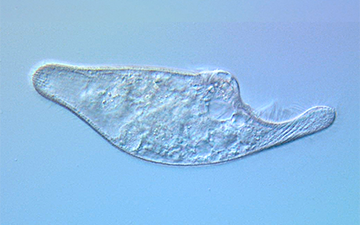Blepharisma is a genus of unicellular ciliate protists found in fresh and salt water. The group includes about 40 accepted species, and many sub-varieties and strains. While species vary considerably in size and shape, most are easily identified by their red or pinkish color, which is caused by granules of the pigment Blepharismin.[1]
All members of the genus possess a long series of membranelles on the left side of the oral groove, and an “undulating membrane” (a structure resembling a flap, scarf or small sail, composed of long cilia fused together as a single sheet) on the right side of the peristome, toward the posterior.[2]
Certain species of Blepharisma have served as model organisms for scientific research. Since some varieties are easily cultured and readily available from scientific supply houses, they are a common object of study in school science classes.
(From: Wikipedia, July 2015)




